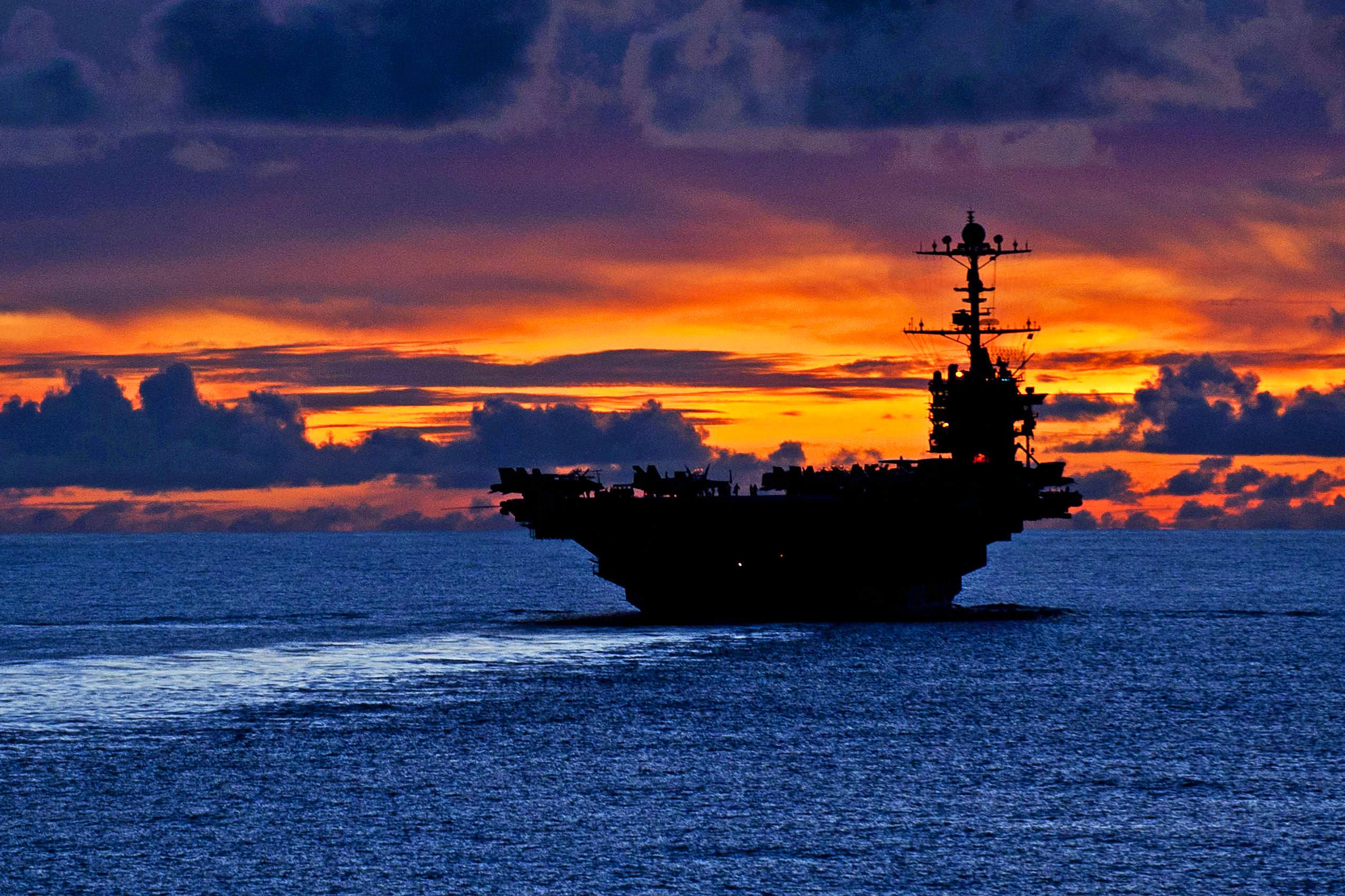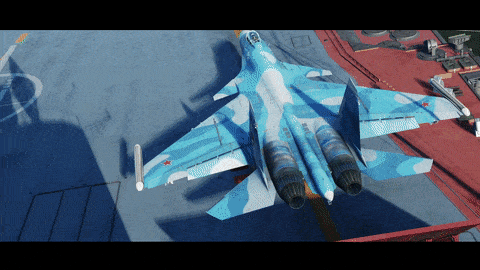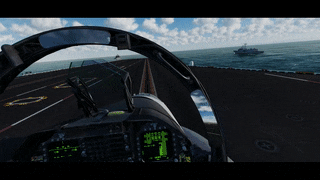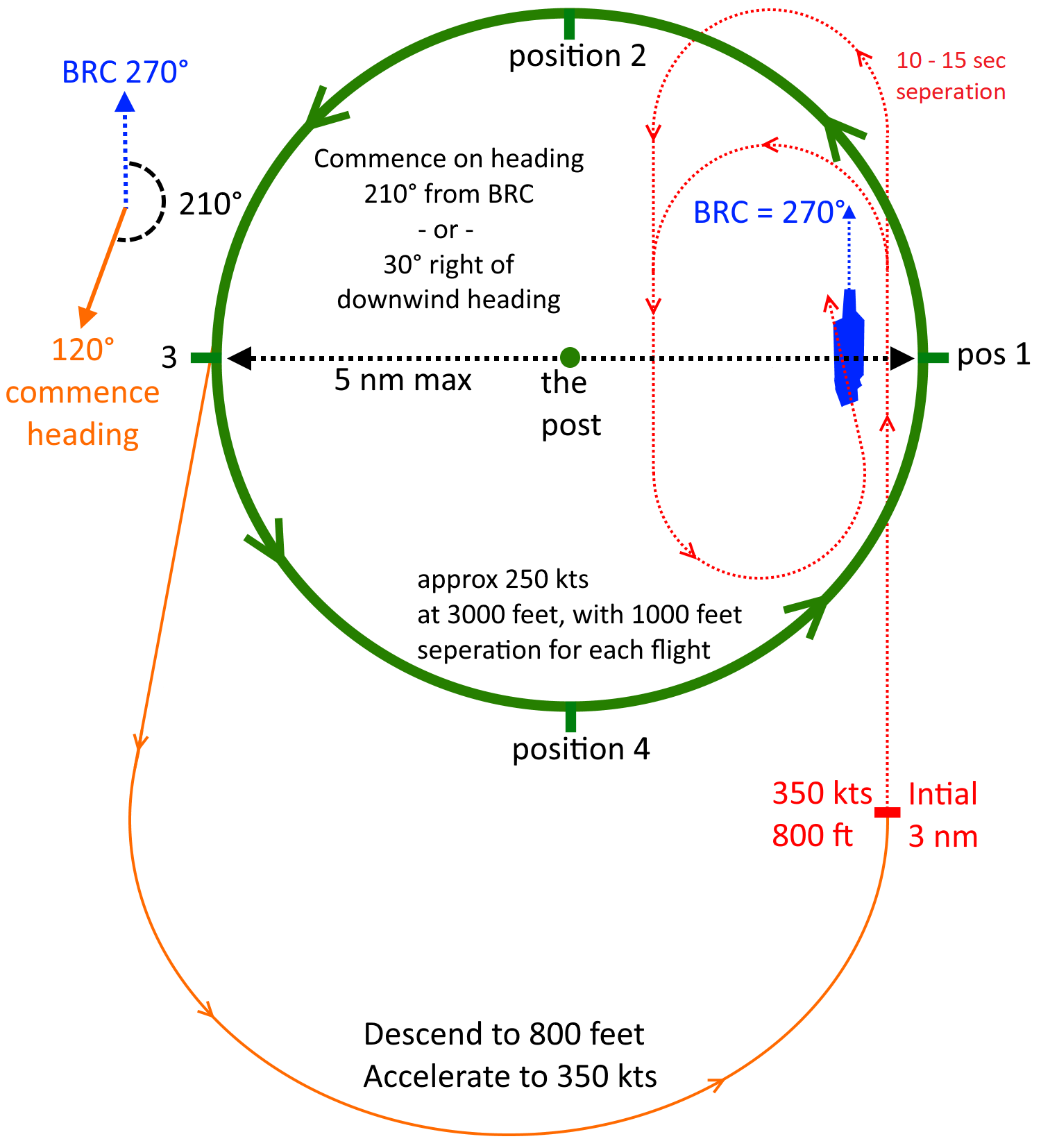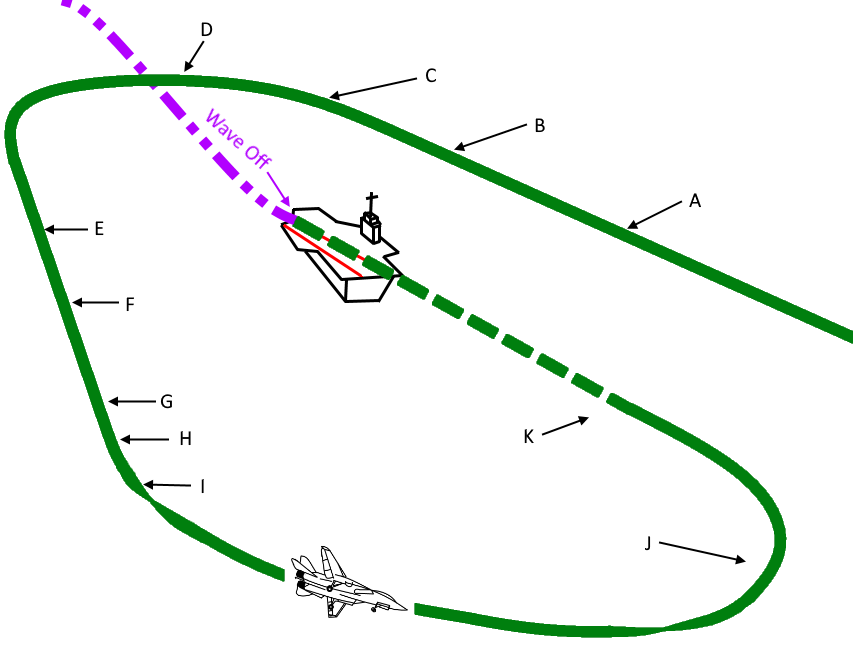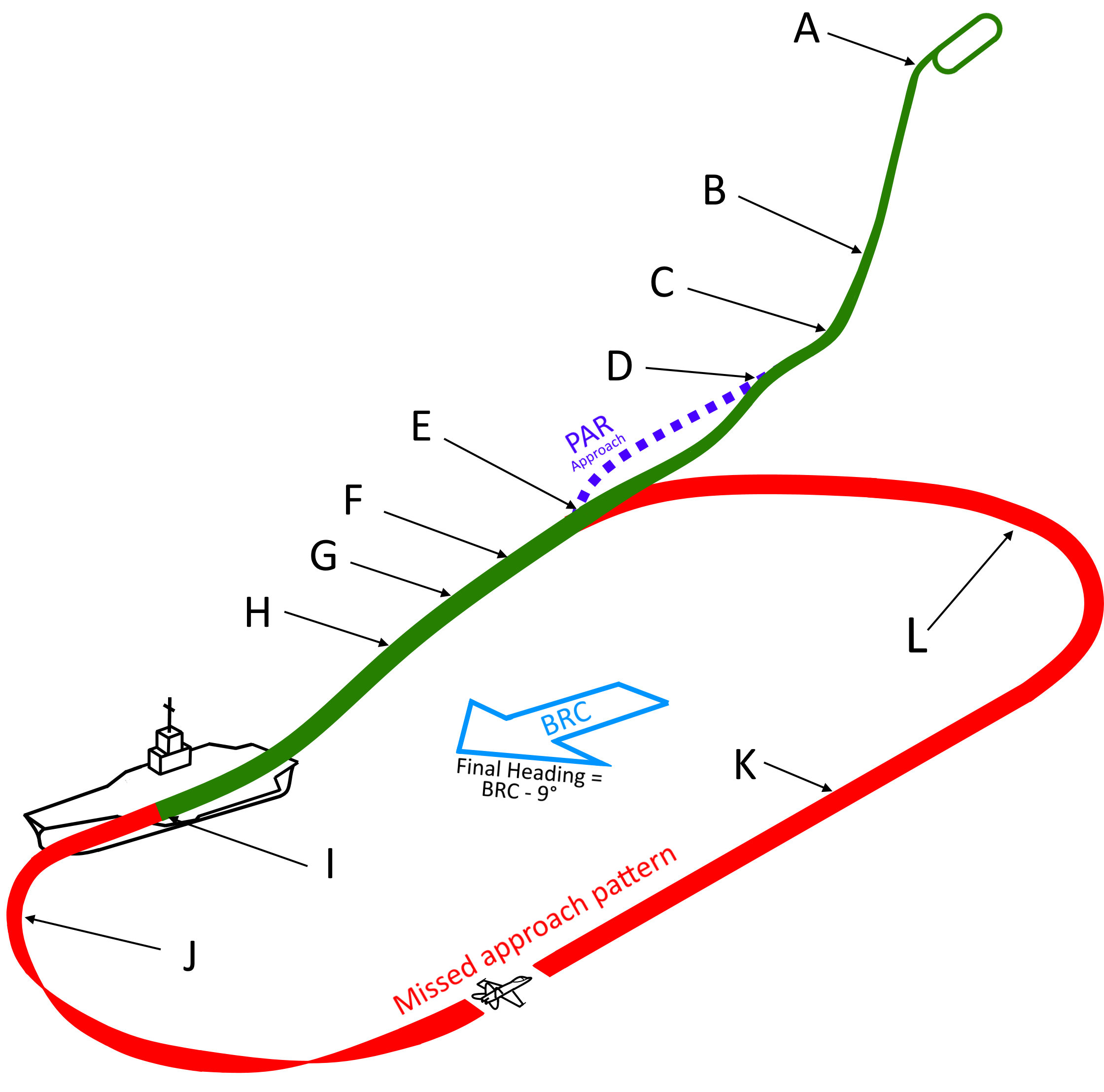Difference between revisions of "Carrier Air Operations"
(→Case 1 Landing) |
(Carrier deck topology) |
||
| Line 75: | Line 75: | ||
=== Carrier Deck Layout === | === Carrier Deck Layout === | ||
| − | + | Let's first familiarize ourselves with the overall carrier deck layout (topology). Unlike an airfield, where there is space aplenty, the carrier is quite cramped and often busy with other aircraft, so knowing where you are going (and not hindering others) is vital. | |
[[File:ACTUAL_CARRIER_TOPOLOGY.png|right|800px]] | [[File:ACTUAL_CARRIER_TOPOLOGY.png|right|800px]] | ||
| − | + | All (modern) aircraft carriers more or less have the same layout: the figure here shows the diagram of the USS Nimitz class carriers, but we could still apply the location names to all other carriers (including carriers such as the Russian Admiral Kuznetsov). | |
| − | + | Objects such as parked aircraft or munition carts can be placed on the aircraft deck (by the mission developer): even if they are not moving ('static') they can till be collideable. So ensure your path and catapult '''are clear before moving''', before finding out on take-off that there is an aircraft parked on the catapult. | |
| − | The most | + | The most critical locations on an aircraft carrier are the '''catapults''' or ramp (marked in green and numbered), and the '''landing deck''' (between the red stripes, with yellow centerline). These are for respectively launching aircraft (taking off) and recovering aircraft (landing), so like a runway, '''do not block them'''. Typical recovery or departure intervals are approximately 20 to 30 seconds, so try to cross them quick if you have to and be wary of other aircraft. |
| − | + | {| class="mw-collapsible mw-collapsed wikitable" | |
| − | + | ! colspan="6" style="text-align: center; background-color:#f8a102;" | | Carrier Topology List | | |
| − | + | |- | |
| − | + | | style="background-color:#f8a102;" | # | |
| − | + | | style="background-color:#f8a102;" | Name | |
| − | : | + | | style="background-color:#f8a102;" | Location |
| − | ; | + | | style="background-color:#f8a102;" | Colour |
| − | : | + | | style="background-color:#f8a102;" | Function |
| − | + | | style="background-color:#f8a102;" | Notes | |
| − | + | |- | |
| − | ;4 | + | | 1 |
| − | : | + | | Landing Deck |
| − | ;5 | + | | Slanted along deck |
| − | + | | Between red lines, | |
| − | ;6 | + | with yellow centerline |
| − | : | + | | Landing aircraft |
| − | + | | Keep clear at all times | |
| − | : | + | |- |
| − | ;8 | + | | style="background-color:#accf40;" | 2 |
| − | : | + | | style="background-color:#accf40;" | Catapults |
| − | ;9 | + | | style="background-color:#accf40;" | Bow (front) |
| − | + | | style="background-color:#accf40;" | In green, | |
| − | ;10 | + | JBD in light blue |
| − | : | + | | style="background-color:#accf40;" | Launching aircraft |
| − | ; | + | | style="background-color:#accf40;" | Be mindful about |
| − | : | + | parked aircraft |
| − | ;12 | + | obstructing catapults |
| − | : | + | |- |
| − | ;13 | + | | 3 |
| − | + | | Island | |
| − | ;14 | + | | Starboard, |
| − | : | + | midways ship |
| − | + | | In purple | |
| − | + | | Ship control, | |
| + | aircraft control tower | ||
| + | | Waive to your Airboss | ||
| + | |- | ||
| + | | style="background-color:#accf40;" | 4 | ||
| + | | style="background-color:#accf40;" | Elevators | ||
| + | | style="background-color:#accf40;" | Edge of ship | ||
| + | | style="background-color:#accf40;" | In blue | ||
| + | | style="background-color:#accf40;" | Transporting aircraft | ||
| + | to hangar / deck | ||
| + | | style="background-color:#accf40;" | | ||
| + | |- | ||
| + | | 5 | ||
| + | | Crotch | ||
| + | | Bow (front) | ||
| + | | Black | ||
| + | | Do NOT use for landing lineup | ||
| + | | | ||
| + | |- | ||
| + | | style="background-color:#accf40;" | 6 | ||
| + | | style="background-color:#accf40;" | Box | ||
| + | | style="background-color:#accf40;" | Between catapults | ||
| + | #1 and #2 | ||
| + | | style="background-color:#accf40;" | Black | ||
| + | | style="background-color:#accf40;" | Shooter / | ||
| + | catapult control | ||
| + | | style="background-color:#accf40;" | Little hut where the | ||
| + | catapult controller sits | ||
| + | |- | ||
| + | | 7 | ||
| + | | Point | ||
| + | | Starboard bow | ||
| + | | | ||
| + | | QRA: Quick Reaction Alert | ||
| + | | Parking aircraft for quick | ||
| + | reaction air support | ||
| + | |- | ||
| + | | style="background-color:#accf40;" | 8 | ||
| + | | style="background-color:#accf40;" | Corral | ||
| + | | style="background-color:#accf40;" | Between elevators | ||
| + | #1 and #2 | ||
| + | | style="background-color:#accf40;" | | ||
| + | | style="background-color:#accf40;" | Parking | ||
| + | | style="background-color:#accf40;" | | ||
| + | |- | ||
| + | | 9 | ||
| + | | Street | ||
| + | | Midship / Center | ||
| + | | | ||
| + | | Access to elevators, corral, sixpack | ||
| + | | | ||
| + | |- | ||
| + | | style="background-color:#accf40;" | 10 | ||
| + | | style="background-color:#accf40;" | Sixpack | ||
| + | | style="background-color:#accf40;" | Midship / Center | ||
| + | | style="background-color:#accf40;" | | ||
| + | | style="background-color:#accf40;" | Parking | ||
| + | | style="background-color:#accf40;" | | ||
| + | |- | ||
| + | | 11 | ||
| + | | Junkyard | ||
| + | | Between island and | ||
| + | elevator #3 | ||
| + | | | ||
| + | | Parking of AWACS, Tanker, | ||
| + | Transport aircraft | ||
| + | | | ||
| + | |- | ||
| + | | style="background-color:#accf40;" | 12 | ||
| + | | style="background-color:#accf40;" | Patio | ||
| + | | style="background-color:#accf40;" | Starboard stern | ||
| + | | style="background-color:#accf40;" | | ||
| + | | style="background-color:#accf40;" | Parking | ||
| + | | style="background-color:#accf40;" | | ||
| + | |- | ||
| + | | 13 | ||
| + | | LSO | ||
| + | | Port stern | ||
| + | | | ||
| + | | Landing Officer | ||
| + | | Bunch of guys grading | ||
| + | your landing | ||
| + | |- | ||
| + | | style="background-color:#accf40;" | 14 | ||
| + | | style="background-color:#accf40;" | Finger | ||
| + | | style="background-color:#accf40;" | Port stern | ||
| + | | style="background-color:#accf40;" | | ||
| + | | style="background-color:#accf40;" | Parking | ||
| + | | style="background-color:#accf40;" | | ||
| + | |} | ||
Knowing these areas by name is certainly not required, but know to keep the landing deck clear! | Knowing these areas by name is certainly not required, but know to keep the landing deck clear! | ||
Revision as of 14:58, 15 December 2018
Carrier Air Operations are the various procedures and techniques that make up landing on a moving ship, usually several miles away from any solid ground on which you can land instead. Both fixed-wing and rotary wing aircraft can make use of aircraft carriers to land on, as well as STOL / STOVL aircraft such as the Harrier and the F-35B. Because of the relatively small size (compared to a fully fledged land-based airport) of the carrier, strict procedures and rules are employed to avoid accidents (such as airplanes crashing into one another).
Contents
Carrier Basics
Before we dive headfirst into the procedures and rules associated with carrier air operations, we will first go over the various basics that come into play when operating on a carrier. These include items such as how does a carrier work, what does a carrier look like, and what sort of key features should you pay attention to when you cannot make out left from right when operating on a busy carrier.
Carrier Features
Simply put an aircraft carrier is a floating airfield for naval aviators (pilots in the Navy and the Marine Corps) to take-off and land when doing their missions. Normally an airplane can use a fully sized runway for taking off or landing, with the size of these runways landing somewhere in the ballpark of 6000 - 12000 feet. For obvious reasons we cannot have a ship that is that long, so all manner of studies and experiments have allowed us to reduce the size of the runway needed for carrier planes. This started all the way back to the early 1900's, though the carrier became a main staple just prior to / with the beginning of the Second World War.
Arresting gear
Early carriers and carrier planes were remarkable similar to the ones used for conventional landing on airfields and airstrips, but as planes got bigger and started carrying more ordinance (torpedo's, rockets and bombs) the increase in weight meant that the airplanes could not be stopped in time or slow down enough to safely land on the carrier.
A rather simple but ingenious solution was devised: they would span a number of wires (3 ~ 4) across the deck, and bolt a hook to the aircraft that could catch these wires. As soon as a landing aircraft trapped one of these arrestor wires it would slow down rapidly and be landed safely (although decelerated quite harshly). This system is still in use today (in a more modern form) and the method used for landing all fixed-wing aircraft on the carrier. STOL/STOVL (such as the F-35) and helicopter aircraft obviously do not require the arresting wires, as they can land (semi) vertically on the carrier deck.
Arrestor wires function by having an pneumatic system limit the rate at which the amount of wires can be pulled out (dissipating the energy in a controlled fashion). Typically a large hydraulic ram is used that forces fluid through a small diameter hole, so that it slows the aircraft (smoothly) down more the more wire is pulled out. In the early days a barrier (basically a large and strong net) was used as a backup for when an aircraft would fail to trap any wire; nowadays they are reserved for emergencies only.
To faciliate the trapping of planes on carriers they have to be equipped with a hook to catch (or trap) one of the wires (typically up to 5 wires are used on carriers): because the landings are also tougher on the undercarriage of the airplanes, most naval based aircraft also have a much sturdier and bigger gear to be able to withstand the shock of landing on the carrier.
Prior and shortly after the invention of the arrestor wires, the deck was typically rectangular in shape, meaning aircraft landing where in direct conflict with aircraft taking off (so it could not be done at the same time). It was not until the early 70's that they invented the angled landing deck, so that landing aircraft were offset by several degrees from the catapults and aircraft taking off; from then on both recoveries and takeoffs could be performed simultaneously.
Ski ramps (STOBAR)
In the early days of the carrier (World War 2) most carriers were ships over which a flat deck superstructure was built, to be used by the air carrier wing (planes). Even after being equipped with the previously mentioned arrestor gear and barrier, the take-off procedure was unceremoniously going to full power and simply leaping off the edge of the carrier going at full till. This was possible because of propeller planes having a high thrust-to-weight ratio: they put out a high amount of power whilst the total weight of the aircraft is relatively low.
The introduction of jet engines, heavy electronic equipment (radar, targeting sensors) and various types of air-to-air and air-to-ground weaponry meant a significant increase in overall aircraft weight. As such, fixed wing aircraft lost their high thrust-to-weight ratio and could not reliably take off under their own power any longer. The Russians / Soviet bloc adapted a stratagem of high thrust engines combined with weight restrictions and mandated lower overall weight of their aircraft; they also adopted the ski ramp on their carriers.
Visually and effectively similar to a ramp one might see at a ski resort, the planes line up on the designated positions on the carrier and removable chocks come up from inside the carrier deck to hold the aircraft in place. The JBD (Jet Blast Deflectors) are raised behind the aircraft to allow for maximum (afterburning) power to be used: the JBD prevent aircraft from being blown off the aircraft deck. Some naval jet aircraft (particularly those of Russian variety) may have an additional engine power override mode reserved for use with carrier takeoffs.
The ski ramp increases both the altitude (though marginally) and the Angle of Attack / attitude of the aircraft launched: the particular combination allows an aircraft with a high thrust-to-weight ratio to become airborne under its own power (there is no requirement on an external power source). The ramp itself also requires significantly less maintenance (and cost) than the contemperary CATOBAR system used by most NATO countries and the US.
The largest drawback of the STOBAR ( Short Take-Off But Arrested Recovery ) ramp system overall is the reduced weight an aircraft can field, limiting the amount of weapons and fuel that can be brought with on a departure from the carrier (though refueling is commonplace after taking off from the carrier). Another drawback is the reduced size of the usable carrier deck, as you can't park aircraft on the ramp.
Catapults (CATOBAR)
Rather than implement the CATOBAR ramp system, the United States (whom pioneered the system) and most NATO countries instead use the CATOBAR (Catapult Assisted Take-Off But Arrested Recovery system. The aircraft catapult is a launcher to which an aircraft is hooked up, which is then launched using external power from the carrier (either steam or electromagnetic power).
Up to the Cold War most aircraft used a length of reinforced rope (called a bridle) to attach to the catapult shuttle, but in all aircraft after the Cold War the shuttle instead connects to the nose gear of the aircraft via the launch bar. The pilot can selectively lower the launch bar with a switch in the cockpit to hook up to the catapult (shuttle). This shuttle also holds back the aircraft, so that the engines can be run up to full (afterburning) mode before launching. Once the bar is released remotely by the shooter (the officer in charge of the catapult) the aircraft soars away off the end of the deck and hopefully into the sky.
Carrier Deck Layout
Let's first familiarize ourselves with the overall carrier deck layout (topology). Unlike an airfield, where there is space aplenty, the carrier is quite cramped and often busy with other aircraft, so knowing where you are going (and not hindering others) is vital.
All (modern) aircraft carriers more or less have the same layout: the figure here shows the diagram of the USS Nimitz class carriers, but we could still apply the location names to all other carriers (including carriers such as the Russian Admiral Kuznetsov).
Objects such as parked aircraft or munition carts can be placed on the aircraft deck (by the mission developer): even if they are not moving ('static') they can till be collideable. So ensure your path and catapult are clear before moving, before finding out on take-off that there is an aircraft parked on the catapult.
The most critical locations on an aircraft carrier are the catapults or ramp (marked in green and numbered), and the landing deck (between the red stripes, with yellow centerline). These are for respectively launching aircraft (taking off) and recovering aircraft (landing), so like a runway, do not block them. Typical recovery or departure intervals are approximately 20 to 30 seconds, so try to cross them quick if you have to and be wary of other aircraft.
| | Carrier Topology List | | |||||
|---|---|---|---|---|---|
| # | Name | Location | Colour | Function | Notes |
| 1 | Landing Deck | Slanted along deck | Between red lines,
with yellow centerline |
Landing aircraft | Keep clear at all times |
| 2 | Catapults | Bow (front) | In green,
JBD in light blue |
Launching aircraft | Be mindful about
parked aircraft obstructing catapults |
| 3 | Island | Starboard,
midways ship |
In purple | Ship control,
aircraft control tower |
Waive to your Airboss |
| 4 | Elevators | Edge of ship | In blue | Transporting aircraft
to hangar / deck |
|
| 5 | Crotch | Bow (front) | Black | Do NOT use for landing lineup | |
| 6 | Box | Between catapults
|
Black | Shooter /
catapult control |
Little hut where the
catapult controller sits |
| 7 | Point | Starboard bow | QRA: Quick Reaction Alert | Parking aircraft for quick
reaction air support | |
| 8 | Corral | Between elevators
|
Parking | ||
| 9 | Street | Midship / Center | Access to elevators, corral, sixpack | ||
| 10 | Sixpack | Midship / Center | Parking | ||
| 11 | Junkyard | Between island and
elevator #3 |
Parking of AWACS, Tanker,
Transport aircraft |
||
| 12 | Patio | Starboard stern | Parking | ||
| 13 | LSO | Port stern | Landing Officer | Bunch of guys grading
your landing | |
| 14 | Finger | Port stern | Parking | ||
Knowing these areas by name is certainly not required, but know to keep the landing deck clear!
Carrier Cases
During carrier operations we use 1 of 3 possible cases, with cases each having different approaches and procedures: this is to adjust to the weather and visibility conditions. The carrier will normally dictate which case is currently in use, but mainly it is dependant on the minimum visibility ('horizontal sightlines') and ceiling ('vertical visibility') according to the table below:
| Case | Conditions | Ceiling | Visibility |
|---|---|---|---|
| 1 | No instrument conditions during daytime departures/recoveries | > 3000 ft (910 m) | > 5 nm (9.3 km) |
| 2 | (Light) Instrument conditions during daytime departures/recoveries | > 1000 ft (300 m) | > 5 nm (9.3 km) |
| 3 | Severe instrument conditions during daytime and nighttime recoveries | < 1000 ft (300 m) | < 5 nm (9.3 km) |
Please note that recovering during night time automatically defers you to a case 3 landing, regardless of actual weather and visibility conditions.
Altitudes, ranges and distances
The Air Traffic Controller in charge of the flight procedures around the carrier is called the 'Marshall', and he gets to boss you around for not flying perfectly perpendicular to his nice pattern / approach. He will tell you what case the carrier is currently operating in, gives you permission to transition to a given holding stack (altitude) or move closer to the carrier (zone).
Most notably the Marshall should tell you the BRC, or Base Recovery Course. This the current course that the carrier is moving in, and should be the course that you adhere to for landing your aircraft on the carrier deck: please note that the actual carrier landing deck is offset by 9 degrees from the BRC.
Below are the altitude blocks and zone distances associated with carrier operations:
| Altitude | Zone |
|---|---|
| 6000+ ft | Case 3 Marshall (traffic) stack |
| 3000+ ft | Case 1 holding pattern / stack |
| 1200 ft | Case 3 approach and missed approach |
| 800 ft | Case 1 initial overhead break |
| 600 ft | Case 1 downwind and missed approach |
| 500 ft | Case 1 departure in CCZ |
| 300 ft | Helicopter operations in CCZ |
| Distance | Altitude | Zone |
|---|---|---|
| 50 nm DME | Inf. | CCA, Carrier Controlled Area |
| 10 nm DME | Inf. | Marshall Controlled Area |
| 5 nm DME | 2500 ft | CCZ, Carrier Controlled Zone |
Distances given in DME (Distance Measuring Equipment) are thus identical to distance from the carrier: this distance can be obtained by using the TACAN signal of the carrier or similar equipment (ICLS).
Carrier TakeOff
Carrier Landing
For this chapter we have outline the various carrier cases landing procedures and approaches: for ease of use these are split into the traffic pattern and landing pattern. The traffic pattern is used for approaching to the carrier and holding the in the traffic pattern / stack until you it is your time to land on the carrier (which usually involves waiting for other pilots to land first). The landing pattern goes about explaining the actual steps for the landing approach. Thanks to Kola360 we have also been able to provide you with the relevant communications guide for these cases.
We would like to give a massive 'Thank you' to Jabbers, Kola360 and Redkite for their contributions to making these chapters.
Case 1 Landing
Instructions for Case 1 communications and approach pattern:
| Case 1 Communication | ||||
|---|---|---|---|---|
| # | Location | Pilot action | Messages | Frequency |
| 1 | 17000 ft, 75+ DME
Outside of CCA (~ 50 nm) |
Ask permission from Red Crown to enter. | Pilot: [Red Crown, 118, Mother's 250 for 75, Angels 17]
Red Crown: [118, Sweet/Sweet, contact Strike on Button 3] |
Button 4,
256.000 AM |
| 2 | 12000 ft, 55 DME
Inside CCA Outside Marshall Area (10 nm) |
Ask permission from Strike to enter. | Pilot: [Strike, 118, flight of 2, Mother's 250 for 55, Angels 12]
Pilot: [State 5.4, no Alibis] Strike: [118, Sweet/Sweet, Mother is VFR, Case 1] Strike: [Contact Marshall on Button 2] |
Button 3,
265.000 AM |
| 3 | 9000 ft, 52 DME | Pilot makes call outside 10 nm (but inside CCA).
Contact Marshall to enter CCA. |
Pilot: [Marshall, 118, 2050 for 52, Angels 9, State 5.3]
Marshall: [118, Case 1, BRC is 010, hold at 2000, Charlie Time 22] Marshall: [Altimeter 29.92. Report see me.] Pilot: [118, Wilco] |
Button 2,
264.000 AM |
| 4 | 5000 ft, 10 DME | Pilot has visual on carrier. Cleared to enter stack
(2000 ft, stack 1). Monitor button 1 for other traffic. |
Pilot: [118, See you at 10]
Marshall: [118, Switch Tower on Button 1] |
Button 2,
264.000 AM |
| 5 | 2000 ft, In the Stack | Pilot has obtained Charlie Time from Marshall and
must be 'At Ramp' at given time (2200 hours). |
Zip Lip, unless [safety concerns].
Monitor Button 1 for traffic |
Button 1,
301.000 AM |
| 6 | 2000 ft, In the Stack | Pilot matches speed so he is 'At Ramp'
on Charlie Time |
IMC ONLY
Pilot: [118, Commencing] Pilot: [118, at Initial] |
Button 1,
301.000 AM |
| 7 | 800 ft | Case 1 Recovery | LSO: [3/4 mile, Call the Ball]
Pilot: [118, tomcat/hornet, call/clara, state, auto*] LSO: [Roger Ball] |
Button 1,
301.000 AM |
| Additional case 1 communication | ||||
| 8 | 2000 ft, In the Stack | Air Boss adds Delta Time to given Charlie Time:
'At Ramp' time becomes Charlie Time + Delta Time |
Air Boss: [118, Delta 6] | Button 1,
301.000 AM |
| 9 | 2000 ft, Commencing | Pilot has to go into spin pattern before
heading for the initial break |
Air Boss: [118, Spin It]
Pilot: [118, Spinning] |
Button 1,
301.000 AM |
| 10 | 600 ft, Abeam carrier | Pilot has extend downwind too far and must
return to initial (800 ft starboard of carrier), to redo the case 1 pattern |
Air Boss: [118, too long in the groove,
(an airbus cut you off), wave off and return to pattern] |
Button 1,
301.000 AM |
In the table below we find the relevant steps for the case 1 landing pattern:
| Case 1 Landing Pattern | ||
|---|---|---|
| # | F-14 | F-18 |
| A | 800 ft entry, approx. 300 - 350 kts,hook down, wing sweep 68 | 800 ft entry, approx. 300 - 350 kts,hook down |
| B | Speedbrake[1], radar altimeter to 370 ft | |
| C | Level break at 1.5 ~ 2.0 nm DME; 15 to 17 seconds between breaks,level turn at 800 ft.
Turn should be at 45 ~ 50 degrees of bank or at 10% in G of airspeed (i.e. 330 kts -> 3.3 G). | |
| D | Halfway into turn, set gear down at < 280 ktsand flaps/slats at < 225 kts | Halfway into turn, setgear/flaps/slats at < 250 kts |
| E | Descend to 600 ft, auto throttle[1] | |
| F | On-speed AOA at 15 units, set DLC | On-speed AOA at 8 units |
| G | 600 ft | |
| H | Prepare to turn once abeam of LSO station, at 1 ~ 1.3 nm abeam DME | |
| I | Commence turn once 'round down' visible, turn at ~ 30 degrees bank | |
| J | Maintain AOA, halfway into turn at 500 ft | |
| K | Enter groove at ~ 350 ft (altimeter!), at 3/4 miles, on-speed and call the ball:side number, tomcat/hornet, ball/clara[2], fuelstate[3], (auto[4]) | |
| W | Upon (or prior to) waveoff set full power: return to BRC paralleland intercept pattern at LSO / marshall discretion | |
| Speedbrake / ATC [1] | As desired | |
| Clara [2] | Ball is obscured, LSO will give instructions | |
| Fuelstate [3] | Remaining fuel in thousands of pounds:5100 pounds -> 5.1 | |
| Auto [4] | Auto throttle is engaged | |
Case 2 Landing
Case 3 Landing
| Case 3 Landing Pattern | ||
|---|---|---|
| Pattern | Step | |
| A | Marshall stack: starting at 6000 ft, with increments of 1000 ftfor each flight / package | |
| B | Platform, passing 5000 ft | |
| C | 10 miles DME, 600 ft, commence landing descent | |
| D | 6 miles DME, maintain 1200 ft ACLS (Automated Carrier Landing System)[1] | |
| E | 1.5 miles DME, 600 ft, commence landing descent | |
| F | 1 mile DME, 400 ft | |
| G | 3/4 mile DME, call the ballside number, tomcat/hornet, ball/clara[2], fuelstate[3], (auto[4]) | |
| H | 1/2 mile DME, 200 ft | |
| I | Wave off on Final Heading, climb to 1200 ft | |
| J | Turn to downwind heading, using 10% speed G-turn | |
| K | Maintain 1200 ft and on speed AOA, flaps/slats/gear/hook down | |
| L | Turn into Final Heading via 18 ~ 22 degree bank turn | |
| Speedbrake / ACLS [1] | As desired | |
| Clara [2] | Ball is obscured, LSO will give instructions | |
| Fuelstate [3] | Remaining fuel in thousands of pounds:5100 pounds -> 5.1 | |
| Auto [4] | Auto throttle is engaged | |
| Case 3 Communication | ||||
|---|---|---|---|---|
| # | Location | Pilot Action | Messages | Frequency |
| 1 | 17000 ft, 75+ DME
Outside of CCA (~50 nm) |
Ask permission from Red Crown to enter. | Pilot: [Red Crown, 118, Mother's 250 for 75, Angels 17] Red Crown: [118, Sweet/Sweet, contact Strike on Button 3] |
Button 4,
256.000 AM |
| 2 | 16000 ft, 55 DME
Inside CCA (~ 50 nm), outside Marshall Area (10 nm) |
Ask permission from Strike to enter. | Pilot: [Strike, 118, flight of 1, Mother's 250 for 55, Angels 12] Pilot: [State 5.4, no Alibis] Strike: [118, Sweet/Sweet, Mother is IMC, Case 3] |
Button 3,
265.000 AM |
| 3 | 14000 ft, 52 DME | Ask for assigned stack from Marshall:
Stack is given on radial 082, 22 nm Marshall also gives other key |
Pilot: [Marshall, 118, 250 for 52, Angels 14, State 5.3]
Marshall: [Expected Final Bearing 262, Pilot: [118, Altimeter 29.87, Marshall on the 082, 22, angels 7. Expected approach time 22.] |
Button 2,
264.000 AM |
| 4 | 7000 ft, in holding pattern | Pilot has established holding pattern at 7000 ft: gives fuel state for Marshall to keep track off |
Pilot: [118, established angels 7. State 5.1] | Button 2,
264.000 AM |
| 5 | All flights | Marshall constantly updates all flights with new info: bearing, visibility, altimeter QFH |
Marshall: [118, altimeter 29.88. New final bearing is 265] | Button 2,
264.000 AM |
| 6 | 7000 ft, leaving holding pattern | Pilot notifies Marshall the descent from holding pattern has begun, |
Pilot: [118, Commencing, 29.88, state 4.8]
Marshall: [118, roger] |
Button 2,
264.000 AM |
| 7 | 5000 ft (platform),
descending |
Pilot notifies Marshall he is passing
5000 ft (platform) |
Pilot: [118, platform] | Button 2,
264.000 AM |
| 8 | 1200 - 5000 ft, descend | Marshall hands pilot off to approach
(can happen before reaching platform!) |
Pilot: [118, checking in, state 4.6]
Marshall: [118, switch button 18] |
Button 2,
264.000 AM |
| 9 | 1200 - 5000 ft, descending | Pilot checks in with approach: pilot may be asked to dirty up earlier / later to |
Pilot: [118, checking in, state 4.5]
Marshall: [118, final bearing 262] |
Button 18,
251.000 AM |
| 10 | 1200 ft,
around 4 -8 nm DME |
When ACLS is acquired, approach asks what ACLS ('needles') is showing. If unsatisfactory, new lock will be tried: |
Approach: [118, say needles] Pilot: [405, fly up, on] OR Approach: [118, fly bullseye] |
Button 18,
251.000 AM |
| 11 | 800 ft,
3/4 mile |
LSO chimes in | LSO: [3/4 mile, Call The Ball] Pilot: [118, tomcat/hornet, ball/clara, state, auto*] |
Button 18, 251.000 AM |
References
US Navy Carrier Case 1/2/3 PDF File
Aircraft Carrier Communications, two hours worth of carrier radio chatter

